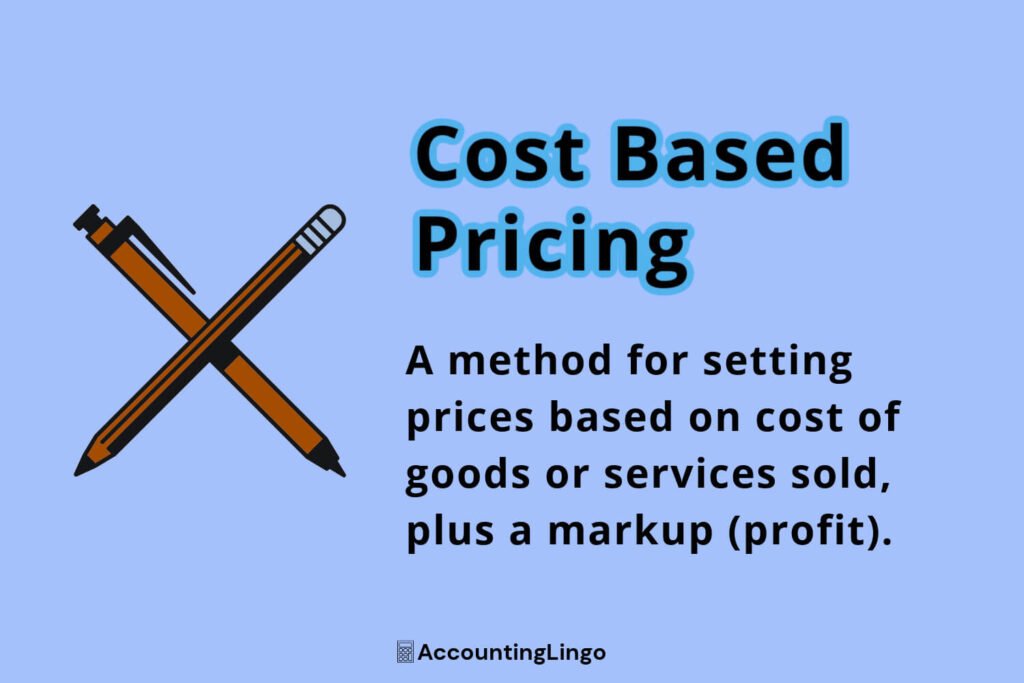
Cost based pricing is a tried and tested approach that considers the costs involved in producing, marketing, and selling your offerings, allowing you to determine a fair and competitive price point.
From understanding fixed and variable costs to calculating profit margins, in this guide, we walk you through the step-by-step process of implementing cost based pricing in your business.
What is Cost Based Pricing?
The definition of cost based pricing includes: a method for setting prices based on cost of goods or services sold, plus a markup (profit).
“Cost Based pricing sets a floor price for desired margins” -University of Oregon
Methods of Cost Based Pricing
Cost based pricing is a strategy that recognizes the costs involved in producing, marketing, and selling an end product. Recognizing these costs allows you to identify fair and competitive pricing for your products or services. Furthermore, cost based pricing assumes that all costs are covered. Different versions of this method exist, each with its own distinct advantages and disadvantages.
The first method is called the cost plus pricing method. It involves factoring the total cost of producing a product or supplying a service, then adding a markup to cover overhead costs and profit. This strategy ensures all costs are covered and allows a consistent profit margin across all product and service offerings.
Another method is target return pricing, also referred to as break even pricing. With this strategy, you identify a target price to achieve a specific return on investment (ROI). This method is ideal when you have a profit goal in mind and want to ensure your pricing strategy aligns with that target.
Formula: Calculate Cost-Plus Pricing
Material+Labor+Overhead Costs Multiplied by (1 + markup amount)
Formula: Calculate Break-Even Pricing
Divide (fixed costs) by (price-variable cost)
Although each method has pros and cons, you must consider your business’s specific needs and goals when selecting a strategy. Understanding these methods better enables you to make more informed pricing decisions.
Advantages & Disadvantages of Cost Based Pricing
This pricing strategy offers several advantages for a business. A main advantage is it ensures all costs are covered, ensuring a consistent profit margin. This is especially important for companies with large fixed costs or variable costs that change with production volume.
Another advantage is a clear and transparent pricing structure. When prices are based on cost, customers can more easily understand how pricing was determined and feel confident they’re receiving a fair deal. This helps foster trust and loyalty, resulting in repeat business and positive word-of-mouth dialogue.
Cost-based pricing does have disadvantages as well. A main drawback is it does not factor customer demand or market conditions. Therefore, this means you’re leaving money on the table if customers would be willing to spend more on your products or services.
Cost based pricing can also be time-intensive and difficult to implement and oversee. This is especially true if your company has many different product or service offerings.
It’s important to contemplate these advantages and disadvantages within the context of your company. This pricing strategy may not be the best fit for every situation, however, it can provide a solid foundation when setting up a profitable and fair pricing structure.
Factors to Consider with Cost Based Pricing
If implementing this pricing strategy within your business, several factors must be considered to ensure prices accurately reflect the true costs involved.
The first factor is understanding fixed costs. These costs are expenses that remain the same regardless of production or sales volume. Examples of these costs may include rent, utilities, or salaries.
Understanding your fixed costs will allow you to allocate a portion of them to each unit of your product or service when calculating the cost-based pricing formula.
Variable costs are another important factor to consider, sometimes referred to as step variable costs. These costs are expenses that change with the volume of production or sales. They may include raw materials, direct labor, or shipping costs.
Calculating variable costs involved with each unit of your product or service allows you to determine the direct cost of producing or delivering that unit.
In addition to fixed and variable costs, it’s important to include overhead costs as well. Overhead costs are indirect costs necessary for your company’s operation, even though they don’t directly relate to your product or service. These costs typically include administrative expenses, marketing costs, and depreciation.
Allocating a portion of fixed, variable, and overhead costs to each unit of production ensures your pricing includes all required costs to run your company.
After clearly understanding your costs, you can calculate a desired profit margin. This identifies the amount of profit you intend to make on each sold unit. When determining profit margin, it’s also important to consider factors like market competition and customer demand.
The profit margin should align with these factors and ensure your pricing is competitive in the long run.
Implementing Cost Based Pricing
Implementing this pricing strategy within your business requires a systematic approach. Following these steps will help ensure your strategy is effective and aligns with your business objectives.
1. Identify Costs
Start with identifying all costs involved with producing, marketing, and selling your products or services. This includes fixed costs, variable costs, and overhead expenses.
2. Allocate Costs
After identifying all costs, distribute them amongst each unit of your product or service. This will provide a better understanding of direct costs associated with each unit of production.
3. Determine Profit Margin
Contemplate factors such as market competition, customer demand, and business goals when determining the profit margin. This will help you identify a price that is competitive and sustainable.
4. Set Your Price
Using the direct cost per unit and your desired profit margin, calculate the price for each unit of your product or service. This will ensure your prices cover all costs and generate the desired profit.
5. Test & Refine
Once you have set pricing, monitor the effectiveness and adjust as needed. This may require conducting market research, analyzing customer feedback, and evaluating the company’s financial performance.
Following these steps will help you implement and oversee pricing in a balanced manner.
Cost Based Pricing Example
To better illustrate this approach, let’s review a few hypothetical pricing examples demonstrating its potential usefulness.
Example 1: TRG Electronics
TRG Electronics is a leading manufacturer that implemented cost-based pricing to set prices for their range of smartphones. By carefully analyzing their fixed and variable costs, TRG could accurately determine the direct cost of producing each individual unit.
They then added a markup to cover overhead expenses and generate a desired profit margin. This approach allowed them to deploy competitive pricing that not only covered their costs but also acknowledges the value of their products.
As a result, TRG experienced a large increase in sales as well as profitability. This helped further solidify their position within the highly competitive electronics market.
Example 2: Max Consulting
Max Consulting is a management consulting firm that implemented cost-based pricing to set fees for their consulting services. By identifying their fixed costs, such as office rent and salaries, and their variable costs, such as travel expenses, Max was able to determine the direct cost of delivering each consulting engagement.
They then added a markup to cover overhead expenses and generate a desired profit margin. This approach allowed Max to set prices that accurately reflect the value of their services to clients. As a result, Max experienced increased client satisfaction and repeat business, establishing itself as a trusted advisor in the consulting industry.
These examples highlight the potential effectiveness this pricing method offers within different sectors.
Pitfalls to Avoid with Cost Based Pricing
Although this strategy can be an effective pricing mechanism, there are common pitfalls businesses should be aware of.
One common issue is relying too much on cost based pricing without considering all other factors like customer demand and market conditions. It’s important to fully understand the value customers place on products or services. Furthermore, neglecting demand and market conditions may result in additional missed revenue opportunities.
Another pitfall is failing to review and update your costs regularly. Costs change over time due to factors like inflation, changes in supplier pricing, and adjusting exchange rates. It’s important to review and update costs periodically to ensure they accurately represent your expenses.
Additionally, businesses should avoid setting prices based solely on competitors. While it’s important to be aware of competitors’ pricing strategies, blindly following their pricing can tremendously erode your profit margins.
It is better to focus on understanding the value your products or services provide and set pricing that accurately reflects such value.
Being aware of and avoiding these common pitfalls will help ensure your cost based pricing strategy is effective and sustainable in the long run.
Other Pricing Strategies to Consider
Even though cost based pricing is common and widely used, it’s important to also consider alternative options that may better suit your business needs. Here are several alternatives to consider:
Value Based Pricing
There’s a big difference between value based pricing vs cost based pricing. Value based places more emphasis on the perceived value of an offer. This approach enables you to set pricing that reflects the value customers place on your products or services instead of simply considering the costs involved. Value based pricing may help you capture additional revenue from customers willing to pay more due to higher perceived value.
Competitive Pricing
This strategy includes setting pricing based on prices charged by your competition. This approach can be effective when operating in a highly competitive marketplace and need your pricing to align with industry standards. Although, it’s important to consider the impact on your profit margins and the value you provide to customers while using this strategy.
Penetration Pricing
Penetration pricing is a strategy in which you set low initial prices to quickly gain market share. This approach may be effective when entering a new market or launching new products and wishing to attract customers. However, it’s crucial to have a clear, longer-term plan for increasing prices to ensure your profitability is sustainable.
Premium Pricing
Premium pricing includes setting higher prices to position your product or service as luxury or higher-end. This strategy can be effective when having a unique value proposition or targeting a niche market willing to pay a premium. However, it’s important to carefully consider market demand and willingness to pay when using this strategy.
These alternative pricing strategies offer additional approaches worth considering that may align well with your business and profitability objectives.
Tools for Cost Based Pricing
Implementing this pricing method throughout your company may be easier with the help of several tools and resources. Here are some worth considering:
- Cost Accounting Software: Accounting tools can help you accurately track cost based activity. Many software programs allow you to input your fixed and variable costs, allocate overhead expenses, and calculate your profit margin.
- Competitor Analysis Tools: Competitor analysis tools can help you gather competitive intelligence, allowing you to make better pricing decisions. Seek out and utilize tools providing competitor pricing, market trends, and customer preferences.
- Market Research: Market research provides insight into customer demand, preferences, and willingness to pay. Consider utilizing surveys, focus groups, or interviews to gather data that will aid you in pricing decisions.
- Industry Publications: Industry publications and websites can provide valuable information on pricing trends, industry benchmarks, and best practices. Stay current with your industry’s latest news and developments to ensure your pricing strategy remains competitive.
Leveraging these tools and resources will enable you to implement cost based pricing more effectively.
Conclusion
Implementing cost based pricing requires careful analysis, regular reviews, and periodic adjustments to ensure its effectiveness and sustainability.
Weighing the pros and cons of this pricing method along with other strategies allows you to pick an option that best aligns with your business needs.
Additional Resources
Other helpful articles may include:
Understanding Material Costs
Stockout Cost: How to Avoid
Cost of Nonconformance
